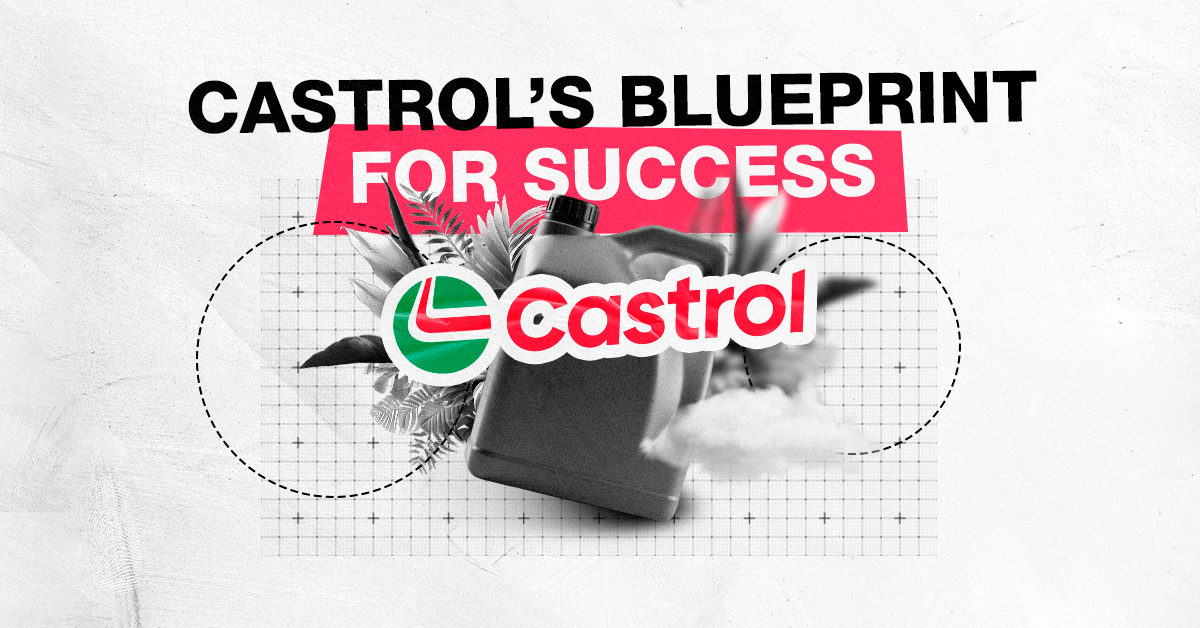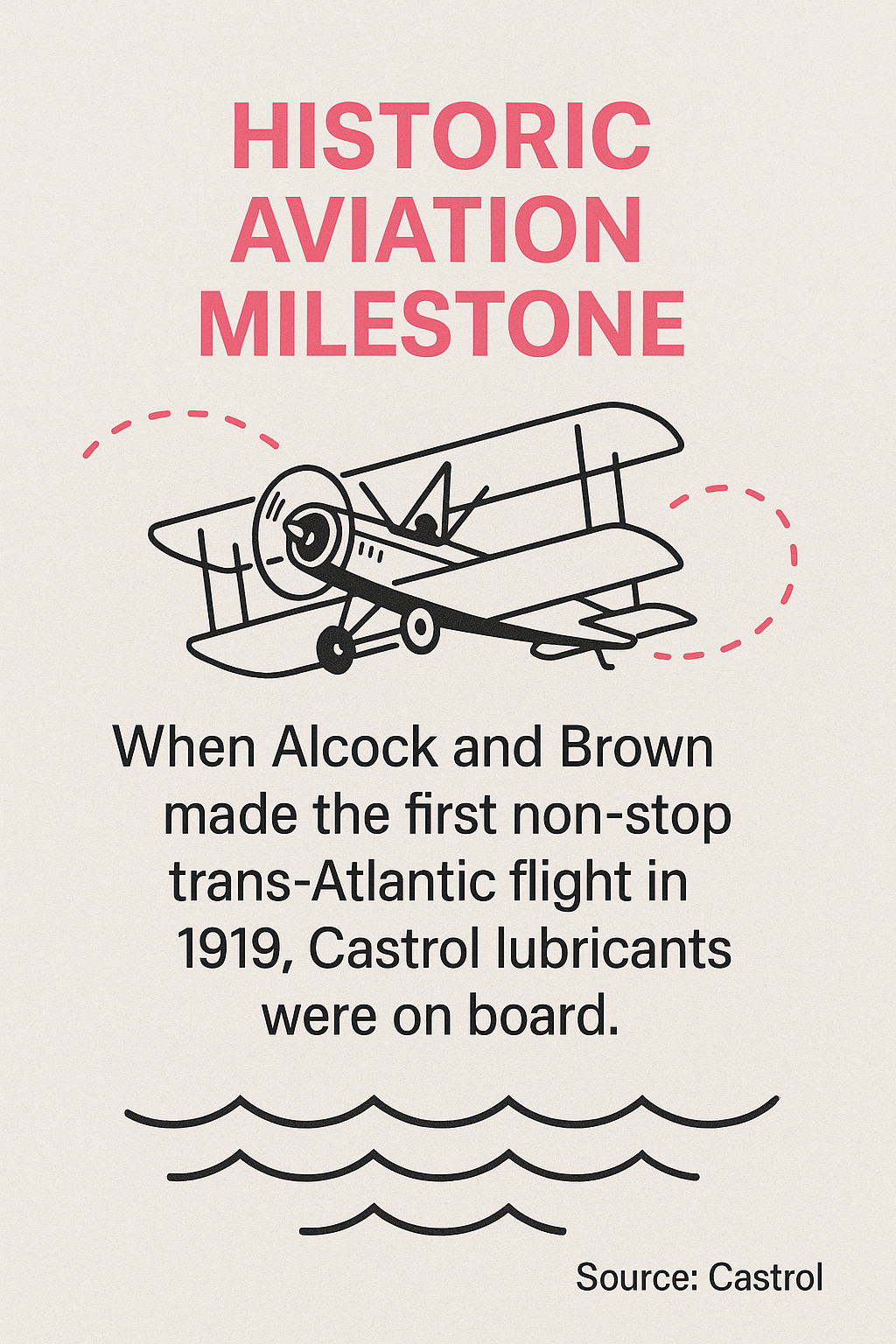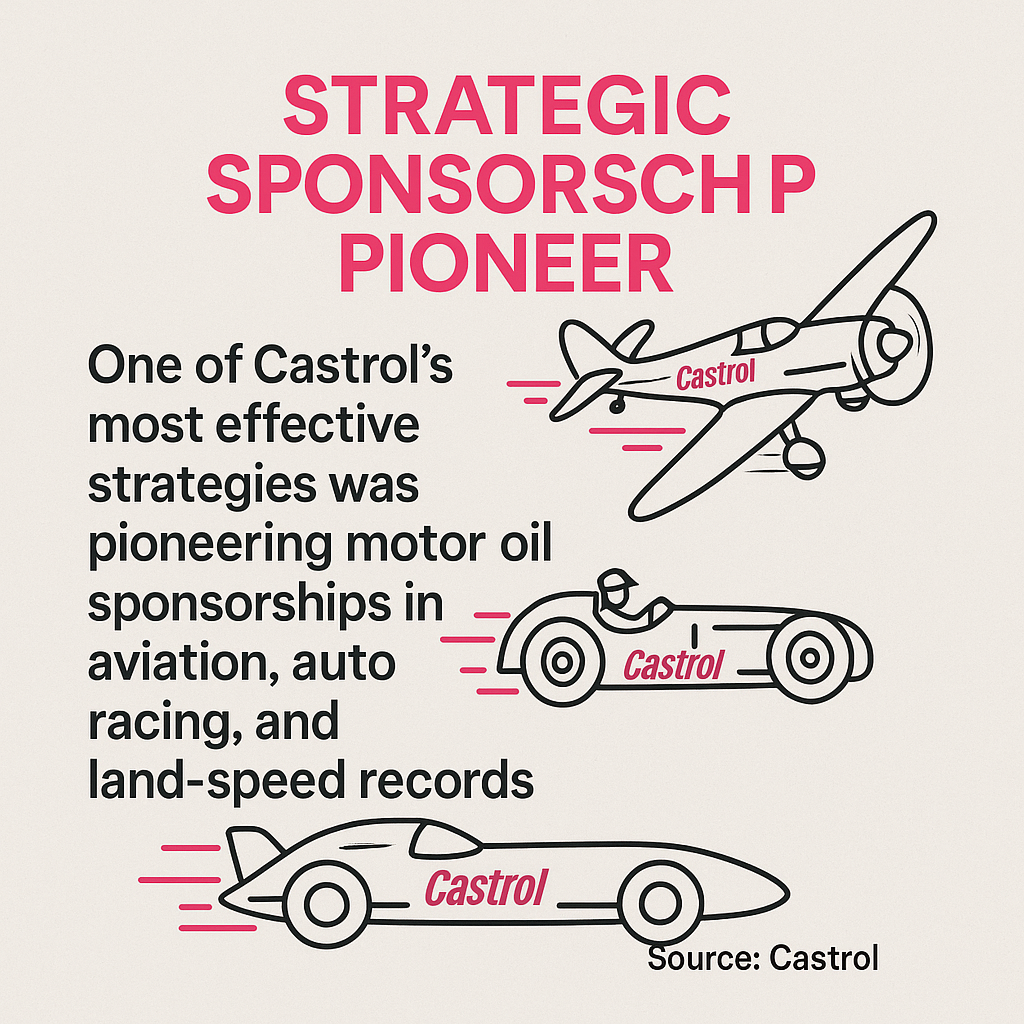
Building a powerful brand in the automotive aftermarket isn't easy. It takes vision, consistency, and strategic thinking – qualities that have defined Castrol's journey from small oil company to global powerhouse. Their story offers valuable lessons for any automotive parts business looking to grow.
In my years working with automotive aftermarket clients, I've seen firsthand how strong branding directly impacts bottom-line results. The companies that thrive aren't just selling products – they're selling trust, expertise, and reliability. That's exactly what Castrol has mastered.
This post explores how Castrol built its global brand and extracts practical lessons you can apply to your automotive parts business. Whether you're a small manufacturer, distributor, or retailer, these strategies can help elevate your brand in a competitive market.
Every great brand has an origin story. Castrol's begins in 1899. Charles Wakefield founded CC Wakefield & Company after leaving his position at Vacuum Oil, focusing initially on lubricants for trains and industrial machinery. (Source: Castrol)

What's striking about Castrol's beginning is that it was built on solving a real problem. Early automobiles and aircraft engines struggled with lubrication issues. Existing oils weren't performing well at high temperatures and speeds. This challenge created the perfect opportunity for innovation.
Rather than simply creating another "me too" product, Wakefield and his team sought a genuine solution. This problem-solving approach remains relevant for today's automotive aftermarket businesses looking to establish their brand.
Sometimes a brand name emerges naturally from innovation. In the early 1900s, Wakefield's researchers discovered that adding castor oil to their lubricant formulations solved critical viscosity issues for automobiles and aircraft engines. This breakthrough led directly to the "Castrol" brand name – a combination of castor oil and "ol" from "oil." (Source: Stablemark)
The name itself highlighted the product's key innovation and differentiation. For smaller automotive businesses today, this illustrates an important principle: your brand name should ideally communicate something meaningful about your unique value proposition.
When working with aftermarket clients, I often stress that the most memorable brand names connect directly to a key benefit or unique aspect of the business. Your name doesn't need to be clever – it needs to be meaningful and memorable.
|
Branding Element
|
Castrol's Approach
|
Application for Smaller Businesses
|
|---|---|---|
|
Brand Origin
|
Founded to solve specific technical problems
|
Identify and address unmet needs in your niche
|
|
Naming Strategy
|
Name derived from key product innovation (castor oil)
|
Connect name to your unique solution or expertise
|
|
Initial Focus
|
Technical performance for specific applications
|
Specialize before generalizing; become known for excellence in one area
|
This foundational approach to brand building has enabled countless smaller businesses to establish a foothold in competitive markets by leading with innovation and specificity.

From the beginning, Castrol positioned itself as a technical leader. The company understood that demonstrating expertise builds credibility. When Alcock and Brown made the first non-stop trans-Atlantic flight in 1919, Castrol lubricants were on board. This high-profile technical achievement provided powerful validation of their product's performance. (Source: Castrol)
Castrol didn't just claim their products were superior – they proved it through real-world applications in the most demanding conditions. This strategy of demonstrating technical excellence remains effective for automotive aftermarket businesses today.
For smaller automotive companies, this highlights the importance of building credibility through evidence rather than just claims. Your customers need proof that your products deliver on their promises, especially when they're used in critical applications.
Building a global brand doesn't happen overnight. Castrol's evolution shows how consistent growth, strategic decisions, and adaptability combine to create lasting success. Their journey provides a roadmap for smaller automotive businesses with big ambitions.
Let's examine the key milestones that transformed Castrol from a specialized lubricant maker into a worldwide brand. Each step offers insights for automotive aftermarket companies looking to expand their market presence.
By 1960, a significant shift had occurred. The Castrol product name had become so well-known that it eclipsed the company name itself. Recognizing this brand equity, the company officially changed its name from CC Wakefield & Company to Castrol Limited. (Source: Castrol)
This decision illustrates an important principle in brand building: recognizing when a product brand has more value than the corporate identity. Smart companies leverage their strongest brand assets rather than clinging to tradition.
For smaller automotive businesses, this suggests regularly evaluating which aspects of your brand resonate most with customers. Sometimes a product line or sub-brand may become your most valuable asset and deserve to be elevated.
Castrol continued to grow through strategic expansion. By 1966, they were acquired by Burmah Oil, forming Burmah-Castrol and accelerating their global reach. Eventually, in 2000, BP purchased Burmah-Castrol for $4.73 billion, but notably kept the Castrol brand intact – a testament to its value. (Source: Wikipedia)
At the time of the BP acquisition, Castrol had built an impressive global footprint with operations in 55 countries and 18,000 employees worldwide. (Source: Wikipedia)
For smaller automotive companies, this growth trajectory demonstrates how a focused brand can expand methodically. You don't need to tackle the entire global market at once – strategic expansion based on your strengths and market opportunities is more sustainable.
|
Year
|
Milestone
|
Strategic Significance
|
|---|---|---|
|
1899
|
CC Wakefield & Company founded
|
Established to address specific market needs
|
|
Early 1900s
|
Introduction of castor oil lubricants and Castrol name
|
Technical innovation leading to distinctive branding
|
|
1919
|
First trans-Atlantic flight using Castrol lubricants
|
Building technical credibility through high-profile applications
|
|
1960
|
Renamed from CC Wakefield & Company to Castrol Limited
|
Recognizing and leveraging product brand equity
|
|
1966
|
Acquired by Burmah Oil, forming Burmah-Castrol
|
Strategic partnership to accelerate growth
|
|
2000
|
BP acquires Burmah-Castrol for $4.73 billion
|
Brand value recognized and maintained despite acquisition
|
This timeline shows how Castrol maintained brand continuity through major transitions – an important lesson for automotive businesses navigating partnerships or acquisitions.
Castrol didn't become a household name by accident. Their marketing strategy combined technical credibility with high-profile visibility. For automotive aftermarket businesses, understanding these approaches can help shape your own marketing efforts.
The most effective elements of Castrol's marketing strategy are surprisingly applicable to businesses of all sizes. Let's examine what made them so successful and how you can adapt their approach.

One of Castrol's most effective strategies was pioneering motor oil sponsorships in aviation, auto racing, and land-speed records. (Source: Castrol) These weren't just branding exercises – they demonstrated the product performing under extreme conditions.
When race cars and aircraft using Castrol products achieved success, it created powerful proof of performance. For consumers, this translated to confidence: "If it works under those extreme conditions, it will certainly work in my vehicle."
For smaller automotive businesses, there's an important lesson here about strategic partnerships. You don't need a Formula 1 sponsorship to build credibility. Look for partnerships with local race teams, automotive influencers, or technical experts who can authentically validate your products.
Going Deeper
Learn how to apply these branding principles to your online auto parts sales strategy for maximum impact in today's competitive market.
Throughout its history, Castrol has maintained remarkably consistent brand messaging centered on technical excellence and performance. This consistency has helped build recognition and trust across different markets and generations of consumers.
Even as marketing channels have evolved from print to television to digital, Castrol's core brand promise has remained stable. They've updated their visual identity and advertising approaches without abandoning their fundamental brand position.
For automotive aftermarket businesses, this highlights the importance of establishing clear brand values and messaging that can evolve in execution but remain consistent in substance. Your customers should always know what your brand stands for, regardless of where they encounter it.
|
Marketing Strategy
|
Castrol's Implementation
|
Small Business Application
|
|---|---|---|
|
Technical Validation
|
High-profile sponsorships in extreme performance environments
|
Partner with local experts, racers, or influencers who can validate your products
|
|
Consistent Messaging
|
Focus on performance and technical excellence across decades
|
Develop core brand messages that remain consistent across all channels
|
|
Visual Identity
|
Distinctive logo and color scheme with gradual evolution
|
Create professional visual branding with flexibility for different applications
|
|
Educational Content
|
Technical information demonstrating expertise
|
Develop content that showcases your product knowledge and solves customer problems
|
Creating a research-backed approach to aftermarket positioning is essential for brand credibility, especially when you're competing with larger companies with bigger marketing budgets.
At its core, Castrol's success has always been rooted in actual product innovation. The strongest brands in automotive aftermarket aren't just marketing machines – they deliver genuine technical advantages. This principle applies regardless of your company's size.
I've noticed that automotive aftermarket companies sometimes undervalue their technical innovations. They solve problems through product development but fail to leverage these achievements in their marketing. Castrol provides a blueprint for connecting innovation to brand building.
Castrol's brand strength began with its technical solution – adding castor oil to improve lubricant performance. Their continued growth was fueled by ongoing product innovation as engines evolved and performance demands increased. Each technical advancement reinforced their brand position.
The company established research and development facilities to ensure continuous improvement. Their ability to create specialized lubricants for different applications – from consumer vehicles to industrial machinery – expanded their market reach while maintaining their technical reputation.
For smaller automotive businesses, this underscores the importance of investing in product development and quality control. Your technical advantages, however modest, should be documented and communicated to customers. Even incremental improvements can become powerful brand differentiators.
These practices help transform technical achievements into brand assets that resonate with customers. Even small companies can build credibility through documented product excellence.
|
Innovation Approach
|
Castrol Example
|
Small Business Application
|
|---|---|---|
|
Problem-Focused Development
|
Addressing viscosity issues with castor oil
|
Identify specific customer pain points to solve
|
|
Application Specialization
|
Creating lubricants for specific environments (aviation, racing)
|
Develop expertise in targeted applications before expanding
|
|
Testing & Validation
|
Proving performance in extreme conditions
|
Create simple but rigorous testing protocols for your products
|
|
Continuous Improvement
|
Ongoing R&D to advance formulations
|
Establish regular product review and improvement cycles
|
When automotive businesses combine genuine innovation with effective communication, they create a powerful foundation for brand building that resonates with technical buyers.
Now that we've examined Castrol's brand-building journey, let's extract specific lessons that smaller automotive aftermarket businesses can implement. You don't need a multinational corporation's budget to apply these principles effectively.
What matters most is taking a strategic approach to brand building with a focus on the elements that create lasting value. Let's break down the most applicable lessons from Castrol's playbook.
Technical credibility forms the foundation of trust in the automotive aftermarket. Castrol established this through high-profile demonstrations and partnerships. For smaller businesses, there are several practical approaches to building similar credibility:
First, document and communicate your testing processes and results. Customers appreciate transparency about how your products are developed and validated. This doesn't require sophisticated laboratories – even basic comparison testing can be valuable when properly documented.
Second, seek third-party validation from respected sources in your niche. This might include certifications, testimonials from professional users, or partnerships with technical experts. How can automotive businesses implement these branding principles effectively in today's digital landscape? Often it starts with identifying the right technical partners.
Finally, create educational content that demonstrates your expertise. Detailed product information, technical guides, and problem-solving content all help establish your brand as a knowledge leader in your category.
Castrol's sponsorships of aviation pioneers and racing teams helped elevate their brand visibility and credibility. While smaller companies have limited sponsorship budgets, strategic partnerships remain valuable for brand building.
Consider partnerships with local motorsports teams, automotive clubs, technical schools, or influential mechanics. These relationships can provide authentic validation for your products at a fraction of the cost of traditional advertising.
Digital partnerships are equally important today. Collaborating with automotive content creators, forums, or specialty websites can extend your brand reach to highly targeted audiences. The key is finding partners whose audience and values align with your brand.
|
Partnership Type
|
Benefits
|
Implementation for Small Businesses
|
|---|---|---|
|
Local Motorsports
|
Product validation in performance settings
|
Sponsor regional race teams or provide products in exchange for feedback and branding
|
|
Technical Education
|
Association with expertise and training
|
Provide products or training materials to automotive technical schools
|
|
Content Creators
|
Extended reach to engaged audiences
|
Collaborate with automotive YouTubers or bloggers for product reviews
|
|
Industry Associations
|
Credibility and networking opportunities
|
Active participation in trade associations relevant to your product category
|
Strategic partnerships become especially powerful when they're sustained over time, allowing for deeper integration of your brand with trusted entities in your market.
One of Castrol's strengths has been maintaining consistent brand messaging across decades and different marketing channels. This consistency helps build recognition and trust, regardless of where customers encounter the brand.
For smaller automotive businesses, consistent messaging starts with clearly defining your brand's core values, unique selling propositions, and key messages. These elements should appear consistently across all customer touchpoints – from your website and packaging to social media and advertising.
Building a strategy for effective email marketing in the automotive aftermarket requires understanding how your brand resonates with customers. The same brand voice and messaging should carry through all your communication channels.
Consistency doesn't mean being static – your brand execution can evolve while maintaining its essential character. The goal is for customers to have the same understanding of your brand regardless of when or where they encounter it.
Theory is valuable, but implementation determines success. Let's translate Castrol's brand-building strategies into practical action steps for your automotive aftermarket business. These approaches can be scaled based on your resources and adapted to your specific market position.
The goal isn't to imitate Castrol exactly, but to apply similar principles in ways that make sense for your unique business. Success comes from consistent application over time, not quick fixes.
Based on Castrol's model and my experience working with automotive aftermarket businesses, here are concrete steps you can take to strengthen your brand:
First, conduct an honest assessment of your current brand position. Survey customers, analyze reviews, and gather feedback from your sales team to understand how your brand is currently perceived. This baseline helps you identify both strengths to leverage and weaknesses to address.
Next, clarify your technical differentiation. What specific problems do your products solve better than alternatives? Document these advantages with concrete evidence – comparison tests, customer testimonials, or performance data. This forms the foundation of your brand's credibility.
Then, develop your brand story that connects your company's purpose to customer needs. Why was your company founded? What problems were you trying to solve? Authentic origin stories create emotional connections with customers when they align with your current mission.
For automotive aftermarket businesses, I've found that successful e-commerce strategies start with a strong brand foundation. The technical and brand elements must work together seamlessly.
|
Implementation Phase
|
Key Activities
|
Success Metrics
|
|---|---|---|
|
Brand Assessment
|
Customer surveys, competitive analysis, SWOT evaluation
|
Clear understanding of current position and gaps
|
|
Identity Development
|
Refine messaging, visual identity, and technical positioning
|
Consistent brand elements ready for deployment
|
|
Internal Alignment
|
Team training, process updates, communication tools
|
All staff consistently representing brand values
|
|
External Deployment
|
Website updates, marketing materials, partner engagement
|
Increased brand consistency across touchpoints
|
|
Measurement & Refinement
|
Track brand metrics, gather feedback, make adjustments
|
Improved brand perception and business results
|
This phased approach helps make brand building manageable, even for smaller companies with limited marketing resources. Focus on executing each phase thoroughly before moving to the next.
Expert Tip
When implementing your brand strategy, prioritize consistency over perfection. It's better to maintain a good brand presence consistently than to create occasional brilliant executions surrounded by inconsistent experiences.
Remember that brand building is a long-term investment. Castrol didn't become a global powerhouse overnight – they built their reputation methodically over decades. The same principle applies to your business, though digital channels can accelerate the process compared to previous eras.
Finally, measure your progress with appropriate metrics. Brand building should ultimately translate to business results – whether that's increased customer loyalty, higher margins, or greater market share. Establish baseline measurements and track changes as you implement your brand strategy.

Castrol's journey from a small specialized lubricant company to a global brand offers valuable lessons for any automotive aftermarket business. Their focus on technical innovation, strategic partnerships, and consistent messaging created a brand that has thrived for over a century.
The most important takeaway is that powerful brands are built on substance. Castrol didn't become a leader through marketing alone – they created genuinely better products, proved their performance in demanding conditions, and consistently delivered on their brand promises.
For smaller automotive companies, this means focusing first on your product and service quality, then effectively communicating your genuine advantages. Authentic brand building starts with creating something truly worth talking about.
As you implement these strategies in your business, remember that brand building is both an art and a science. It requires creativity in how you position and communicate your unique value, but also discipline in maintaining consistency across all customer touchpoints.
The automotive aftermarket continues to evolve with technological changes, shifting consumer preferences, and new distribution channels. However, the fundamental principles of strong brand building remain constant – solve real problems, build genuine relationships, and communicate consistently.
What steps will you take to strengthen your automotive brand? The lessons from Castrol's success provide a roadmap, but the journey is yours to navigate based on your unique strengths and market position.
By applying these principles consistently, your automotive aftermarket business can build a brand that stands out in a crowded marketplace and creates lasting value for your company.
Our customers value boutique agency approach with access to a seasoned team, profit-based goals, and clear communication.



